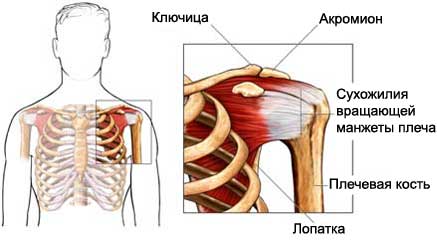Calcific tendinitis of the shoulder joint
Description calcining tendinitis of the shoulder joint
The soft tissue, In this case, the tendons, can form a solid precipitate calcium salts, after which the tendon can become inflamed and cause pain. This inflammation and pain is called calcific tendonitis. Calcific tendonitis usually develops over time. Symptoms usually do not appear, It has not yet formed a precipitate of calcium, then there is a pain in the shoulders.
This disease can be successfully treated. If you suspect, you have calcific tendinitis, consult a doctor.

Reasons calcining tendinitis of the shoulder joint
The exact cause of the disease is unknown. The disorder occurs most often due to the wear and tear of the shoulder joint. A role in its development also plays an aging. Calcific tendinitis of the shoulder joint is more common in older people 40 years.
Risk Factors calcining tendinitis of the shoulder joint
Factors, which increase the likelihood of calcining tendinitis of the shoulder joint:
- Age more 40 years;
- Paul: female
Symptoms calcining tendinitis of the shoulder joint
These symptoms, except calcining tendinitis of the shoulder joint, They may be caused by other disorders. If you experience any of them, consult a doctor.
- Sudden onset of pain;
- Severe pain when moving his shoulders;
- Stiffness in the shoulder;
- Loss of shoulder range of motion;
- The sensitivity of the rotator cuff;
- The loss of muscle strength.
Diagnosis calcining tendinitis of the shoulder joint
The doctor will ask about your symptoms and medical history, a physical exam. You may be directed to a specialist, eg, to an orthopedic surgeon, who specializes in diseases of bones.
Tests may include the following:
- A thorough physical examination – assessment of range of motion and stability of the shoulder;
- Roentgen – test, which uses X-rays, to take pictures of bones. Used to find calcium deposits.
Calcining treatment of tendinitis of the shoulder joint
In most cases, calcific tendonitis extends over time. Treatment options include the following:
Medical treatment calcining tendinitis of the shoulder joint
Methods of treatment include:
- Nonsteroidal anti-inflammatory drugs (NSAIDs);
- Recreation;
- Exposure to heat and / or ice packs;
- Physical therapy to strengthen muscles;
- Prick steroids (eg, kortizona) shoulder – It can be used to reduce inflammation and pain.
Physiotherapy
A physical therapist will use different treatments, to reduce pain and inflammation. Possible treatments include:
- Ice;
- Heat;
- Ultrasound – device, that emits sound waves of high energy, to reduce pain in soft tissues;
- Transcutaneous electrical nerve stimulation – It is used to reduce muscle stiffness or spasmolysis.
Once symptoms begin to decline, you need to start working with a physical therapist, to strengthen muscles and increase range of motion.
Washing
Washing (lavage) It can help to get rid of calcium deposits. Just insert the needle in the shoulder, through which saline. Calcium deposits fall.
Shock wave therapy
The method of treatment involves the crushing of deposits into small pieces, which are absorbed by the body. This should reduce the symptoms of the disease.
Surgery
In some cases, removal of deposits may need surgery. The procedure is called Arthroscopy. It uses small incisions and instruments to study the joint and remove calcium deposits.
Prevention calcining tendinitis of the shoulder joint
Currently, ways to prevent this disease is unknown.
